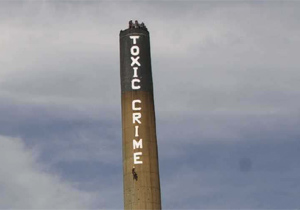
Sheffield incinerator: toxic crime
The quantity of waste we dispose of can be reduced dramatically by local authorities. In Wye in Kent, waste has been reduced by 75%. In Edmonton, Canada (a city of 700,000 people), waste disposal has been reduced by 70% in a few years.
The report 'How to comply with a landfill directive without incineration' shows how. It is a practical guide for local authorities wanting to meet mandatory Government recycling targets and reduce landfill, without incineration. But the systems outlined in this report do more than that. They allow local authorities to begin the transformation from waste disposal to waste utilisation and open up possibilities that could take us way beyond currently perceived 'limits' to recycling and waste minimisation.
The key is in the design of a flexible system based on handling multiple streams of good quality materials. Kerbside collection is necessary, desirable and inevitable. This is widely acknowledged and even the Government's Best Value Indicators now use this as a yardstick for recycling progress. Three stream collection, of organics, dry recyclables and residuals, marks the first step in the transformation.
After source separation, composting is the single most important step that can be taken towards sustainable waste management. Modern in-vessel composters, computer controlled to ensure absence of odours, pathogen kill and high-quality compost provide the technology to enable 'resident friendly' composting in urban and rural areas alike.
Maximum recycling rates are then achieved 'smartly' using customised collection systems, multi-purpose equipment and decentralised sorting and processing. Multi-skilled collectors also provide advice, collect and analyse data from their rounds and implement improvements.
That leaves only the residuals - much diminished but, whether they remain at 10% or 50%, still in need of a place to go. The answer is MBT (Mechanical Biological Treatment). This sorts recyclable waste into further streams of recyclable material, using magnets, grates, air streams, eddy currents and other technology.
Remaining material is then passed to a biological stage, which consists of an enclosed composting system intended to reduce its mass and to render organic materials inert (these will include paper and board, green and kitchen organics, textiles and the organic content within nappies). The residue is greatly reduced in mass and is also stable. Because it is no longer biologically active, its potential to produce methane, leachates and cause landfill fires is greatly reduced or eliminated. It can therefore be safely landfilled, used as landfill cover, or even (if contamination is low enough) used as low grade soil improver or landscaping material. This will depend on the composition of the waste input, which in turn depends upon the degree of source separation achieved.
To finance this, Government spending on waste does need to increase. But there is plenty that local authorities can do, without dramatically increasing spending. This report also lists available sources of additional finance.

